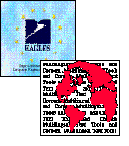
This is a list of standards referred to in the CES or relevant to text encoding generally.
Information Processing--Text and Office Systems--Standard Generalized Markup Language (SGML)
Information Technology -- Text and Office Systems -- Conformance Testing for Standard Generalized Markup Language (SGML) Systems
Sperberg-McQueen, C.M., Burnard, L. (Eds.) (1994) Guidelines for Electronic Text Encoding and Interchange, TextEncoding Initiative, Chicago and Oxford. Available online at
<URL:http://etext.virginia.edu/TEI.html>
Hypermedia/Time-based Document Structuring Language (Hytime)
Standardized SGML document type definitions for books, articles with tables, formulaes, etc.
Representation of dates and times.
"This standard defines a lot of details of the calendar. E.g. the ISO definition of the week numbers is that the first day (day number 1) of a week is Monday and that the first week in a year (week number 1) is the week that includes the first Thursday in January, i.e. the first week that has at least four days in January. Other definitions are, e.g., that hours of a day are counted from 0 to 24 and that the international notation of dates is the Bigendian format year-month-day, e.g. 1993-04-17 and that for time is e.g. 20:36:04 (hh:mm:ss). There are also string formats for computer applications specified that have to represent date and time in files and protocol packets. (See
<URL:ftp://ftp.uni-erlangen.de/pub/doc/ISO/ISO8601.ps.Z>
for a very
detailed
summary.)"
Codes for the representation of currencies and funds
Notation for international telephone numbers (a '+' followed by the country code, followed by a space, ...).
Code for the representation of names of languages
Provides two-letter codes for about 140 languages and is intended primarily for use in terminology, lexicography and linguistics.
The list is available
online
at
<URL:http://www.stonehand.com/unicode/standard/iso639.html>
Code for the representation of names of languages--Alpha-3 code
Three-letter codes for the representation of names of languages for information interchange", developed by a Joint Working Group of ISO TC37/SC2 and TC46/SC2. Covers a wider range of the world's languages than ISO 639.
The list is available online at
<URL:http://www.stonehand.com/unicode/standard/cd639-2.html>
Codes for the representation of names of countries
This standard defines a 2-letter, a 3-letter and a numeric code for each country on this planet. E.g. US/USA/840=United States, DE/DEU/276=Germany, GB/GBR/826=United Kingdom, FR/FRA/250=France, ...). The 2-letter codes are well known in the Internet as top-level domain names. The 3-letter versions are often used at international sports events.
Information Processing -- ISO 7-bit coded character set for information interchange [=ANSI X3.4-1986]
Information Processing -- 8-bit Single-Byte Coded Graphic Character Sets -- Part 1: Latin Alphabet No. 1, ISO 8859-1:1987. Part 2: Latin alphabet No. 2, ISO 8859-2, 1987. Part 3: Latin alphabet No. 3, ISO 8859-3, 1988. Part 4: Latin alphabet No. 4, ISO 8859-4, 1988. Part 5: Latin/Cyrillic alphabet, ISO 8859-5, 1988. Part 6: Latin/Arabic alphabet, ISO 8859-6, 1987. Part 7: Latin/Greek alphabet, ISO 8859-7, 1987. Part 8: Latin/Hebrew alphabet, ISO 8859-8, 1988. Part 9: Latin alphabet No. 5, ISO 8859-9, 1990.
Information technology - Character sets and information coding -Universal multiple-octet coded character set - Part 1 - Architecture and basic multilingual plane
EAGLES Tools subgroup.
DOCUMENT MUL/EAG--LSD1 Version of December 1995.
Guidelines for Linguistic Software Development - Draft proposal
<URL:http://www.lpl.univ-aix.fr/projects/multext/LSD/LSD.html>
"The Unicode Standard, Version 1.1": Version 1.0, Volume 1 (ISBN 0-201-56788-1), Version 1.0, Volume 2 (ISBN 0- 201-60845-6), and "Unicode Technical Report #4, The Unicode Standard, Version 1.1" (available from The Unicode Consortium, and soon to be published by Addison- Wesley).
